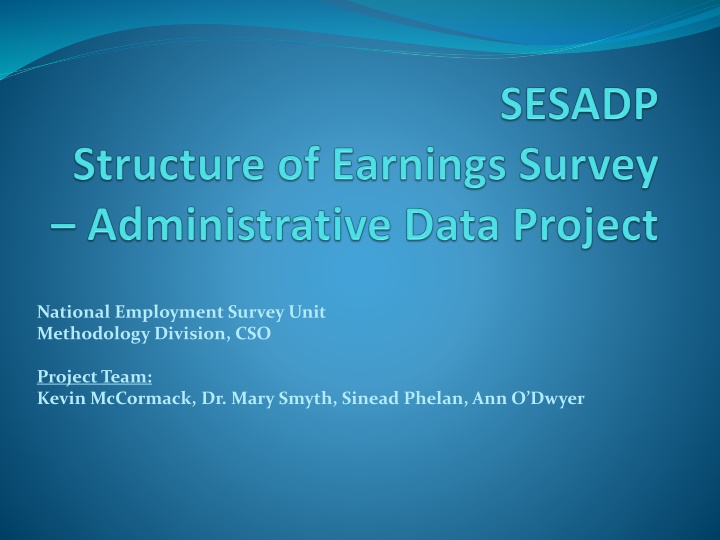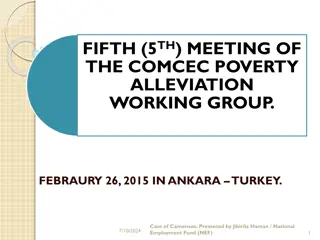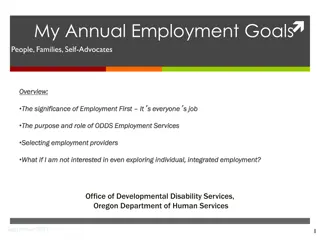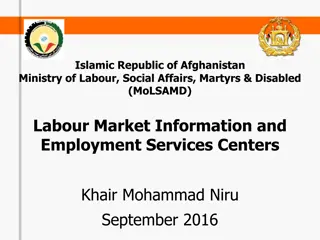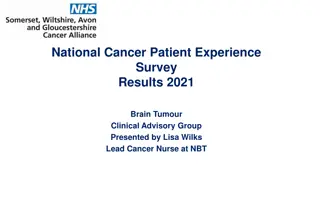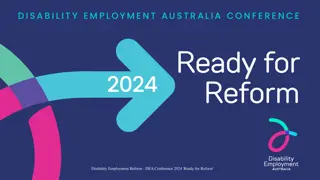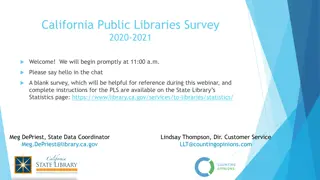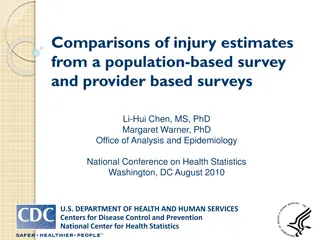National Employment Survey Unit Methodology
This content provides insights into the structure of the National Employment Survey, focusing on the Overview and Publication of earnings data. It discusses the methodologies, data sources, and goals of the survey, including details on mean hourly earnings by educational attainment. The SES-ADP Structure of Earnings Survey is also explored, highlighting the administrative data project's modules and primary data sources.
Download Presentation

Please find below an Image/Link to download the presentation.
The content on the website is provided AS IS for your information and personal use only. It may not be sold, licensed, or shared on other websites without obtaining consent from the author.If you encounter any issues during the download, it is possible that the publisher has removed the file from their server.
You are allowed to download the files provided on this website for personal or commercial use, subject to the condition that they are used lawfully. All files are the property of their respective owners.
The content on the website is provided AS IS for your information and personal use only. It may not be sold, licensed, or shared on other websites without obtaining consent from the author.
E N D
Presentation Transcript
National Employment Survey Unit Methodology Division, CSO Project Team: Kevin McCormack, Dr. Mary Smyth, Sinead Phelan, Ann O Dwyer
Overview Structure of Earnings Survey EU Regulation 4 years met by National Employment Survey (NES) Microdata:- 60,000 employees- Annual & Hourly earnings; Hours worked: Age Gender Education Occupation NACE Full/part-time Nationality Length of Service EU Annual Earnings, GPG National Earnings Statistics RMFs
NES Publication Example of Tables Mean hourly earnings in October 2007 by educational attainment, full/parttime status and sex Male Female Total Level of Educational Attainment Full-time Part-time Full-time Part-time Full-time Part-time Primary or Lower Secondary 17.62 13.15 14.78 13.06 16.88 13.08 Higher Secondary 18.68 12.44 16.36 14.56 17.78 14.15 Post Leaving Cert 20.00 13.31 15.91 15.11 18.89 14.80 Third level non- degree 23.06 14.75 19.37 17.20 21.02 16.90 Degree or higher 31.44 20.06 27.20 23.07 29.18 22.47 Total 21.69 14.11 20.42 15.69 21.17 15.40
SES - ADP Structure of Earnings Survey - Administrative Data Project Project Goal: 2011 & 2012 Annual Earnings Data required - EU & Nationally Administrative Data Response Burden, Cost Effective, Quality, Representative NES Annual Publication Roll-out Infrastructure: 2013 SES 2014
5 Modules 1) Research & Identify Potential Sources ADS 2) Linking Data Sources 3) Modelling non-available characteristics 4) Construction of the SESADS 5) Publish Results
(M1) Research & Identify ADS 7 Administrative Data Sources 2 External Revenue P35L Dept. Social Protection 5 CSO Census EHECS CBR SILC QNHS
Fig. 1: SESADS primary data sources DSP P35L CBR QNHS SESADS EHECS SILC COP
(M2) Linking Data Sources An analysis was undertaken of the data fields contained within the SESADS sources. Unique Identifiers: Per_IdNo. (PPS No. anonymised) - employees Ent_nbr (unique Enterprise Number ) - employers Most suitable unique identifiers (UI) to link: CSO s data sources, DSP and Revenue Commissioners P35L data files
Fig.2: Construction of the SESADS SESADS COP/QNHS/SILC Per_IdNo & ICA Occupation, DSP NACE, Demographics, Per_IdNo., Demographics Education, Earnings CBR/EHECS Per_IdNo. Ent_nbr, Enterprise location, Size, and NACE P35L Per_IdNo. Ent_nbr, Gross annnual earnings, Weeks worked
Identity Correlation Approach (1) Census No Unique Identifier Linking social data sources (Census) is a greater challenge for the CSO. No Unique Identifiers (UIs), such as a PPS No. UIs were developed by following an identity correlation approach (ICA), e.g. combining date of birth, Gender , County live and NACE. E.g. 29101990|F|CORK|85| This identity correlation approach enabled the social data sources to be linked SESADS Currently contains 1 million of the approx. 1.3 million F/P time employees in the State Quality checked 800,000 records, Representative of the NACE sectors,
Identity Correlation Approach (2) Annual Births YoB = 63,000 DoB 63,000 / 365 days = 173 Gender 2 = 86 NACE 14 = 6 (17) County 26 (3) = 1 (5) E.g. 29101990|F|85|CORK|
On completion of Module 2 - SESADS will contain all employees in the State, Gross Annual/Weekly Earnings classified by: Variables Sources NACE, Gender, Enterprise Size group, Public/Private sector, Weeks worked, ------------------------------------------- P35L CBR EHECS DSP -------------------- Occupation, Area of residence, Education, Age, Nationality. COP QNHS SILC
Module 3: Modelling of non-available characteristics Employee characteristics to be modelled are: (1) Hours Worked (2) Annual bonuses (3) BIK (benefit in kind) (4) full/part-time employment status for employees. A multiple imputation methodology will be employed to carry out this stage of the Project. EHECS,QNHS and SILC data sources will be leveraged to provide the base information. Once this model is completed, the SESADS will fulfill both the Eurostat annual and 4- yearly Eurostat SES earnings requirements.
Module 4: Construction of the SESADS The SESADS will be constructed in the CSO s Administrative Data Centre (ADC) Structures (known as layers) consistent with those as outlined in the ESSnet on microdata linking and data warehousing in statistical production. SES EU microdata format
Module 5: Publication of Results The first set of SES statistics for 2011 and 2012 (gender pay gap and average earning) were submitted to Eurostat in November 2013. Finalised datasets with more detail will be available mid- 2015 NES Publication
Timetable SESADP signed off 2015 SES 2011 & 2012 Data NES Publication Roll out Project infrastructure for 2013 & 2014 data Assess by end 2015 SES 2014 Microdata- submitted to Eurostat mid-2016 - ends-
Cost Benefit Analysis Business Survey V s SESADP -- 1 FTE (3.5) 0.1 m ( 0.2m) -- T+ 10 months Revenue data 1 million None 15 persons Cost 1.5 million -- T+ 18 months Quality Data Edits -- Sample (70K) -- Burden (10K Ents, 70K ees) --
Thanks to: CSO Divisions: - Cork Dublin STS cross division support EHECS ADC CENSUS Earnings Analysis CBR QNHS SILC IT Etc.
